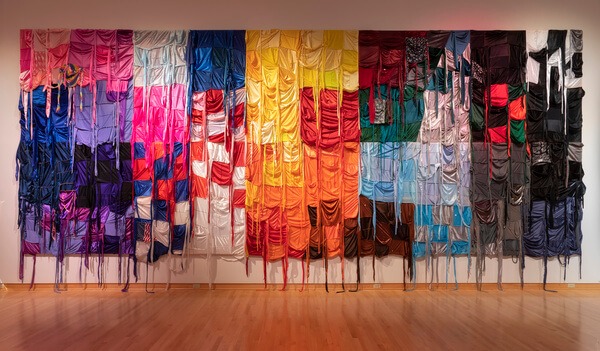
JMK Art Center exhibit “Magic City”, First-Ever Solo Exhibition by Nigerian-American Artist Anthony Olubunmi Akinbola
Despite the brilliant colors, it may be the Blackest installation ever to grace the John Michael Kohler Art Center’s white walls. The imagery and objects comprising “Magic City,” the first-ever solo exhibition by Nigerian-American artist Anthony Olubunmi Akinbola, tell a powerful story of Black American culture through a fetishist lens using new works created entirely for JMKAC.
Anchored by a 2006 Cadillac Escalade owned by the artist and recast as a “sound sculpture” at its center, “Magic City” is framed by three immense tapestries woven from “durags,” collections of brightly colored head scarves worn by early African slaves working in the fields. The scarves were later used during the Harlem Renaissance for their ability to preserve the waves in Black hairdos, and more recently adapted as cultural symbols by Black American males, including hip-hop artists.
The thread continues with a constellation of 401 plastic hair picks embedded in a wall, or one for each year since 1619 when African slaves first appeared in the New World. Nearby, 500 cans of Murray’s Original Pomade, a popular hair dressing among Black Americans since the 1920s, form three towering sculptures. There are even African-style wooden folk sculptures whose traditional nails have been replaced by Torino hairbrushes, bringing yet another element to the fetishist theme that uses commercial products to help depict aspects of Black American culture.
“With a wry and thoughtful approach, Anthony uses asymmetric information as a tool to complicate and question issues surrounding identity, commodity fetishism, popular culture, and ritual under capitalism,” says senior curator Kaytie Johnson. It’s a striking exhibit, and unlike most that has ever graced the Sheboygan art museum, both in its imagery and layered meanings.
“According to the artist, this is a type of Black sanctuary that addresses Blackness through the prism or lens of fetishism,” says Johnson, who curated the exhibit. “Anthony draws his inspiration from early African material culture and creates an arc from that culture to the present day.”
Akinbola, a Columbia, Missouri, native who now lives in Brooklyn, New York, also draws his inspiration from Karl Marx’s “religion of sensuality” to create what the curator describes as a show of no small political depth.

